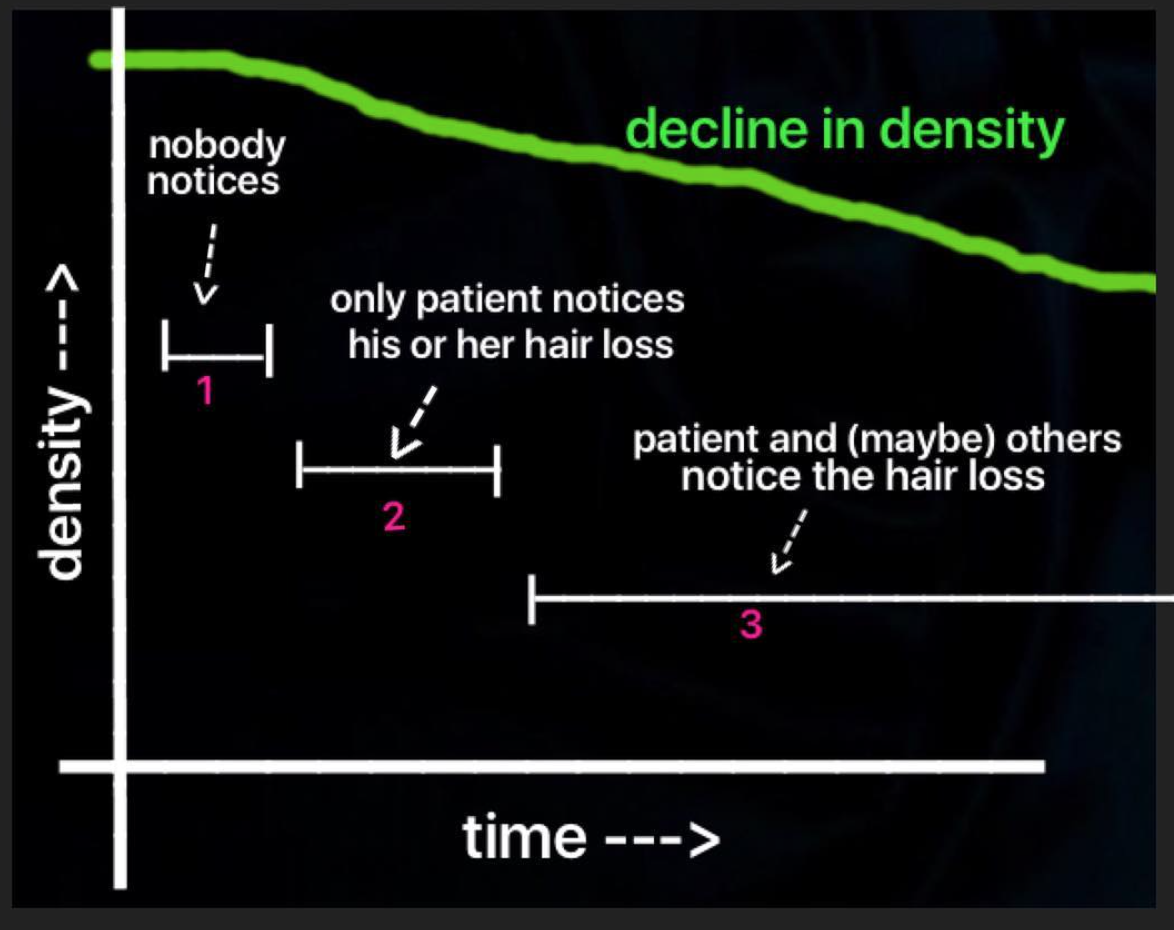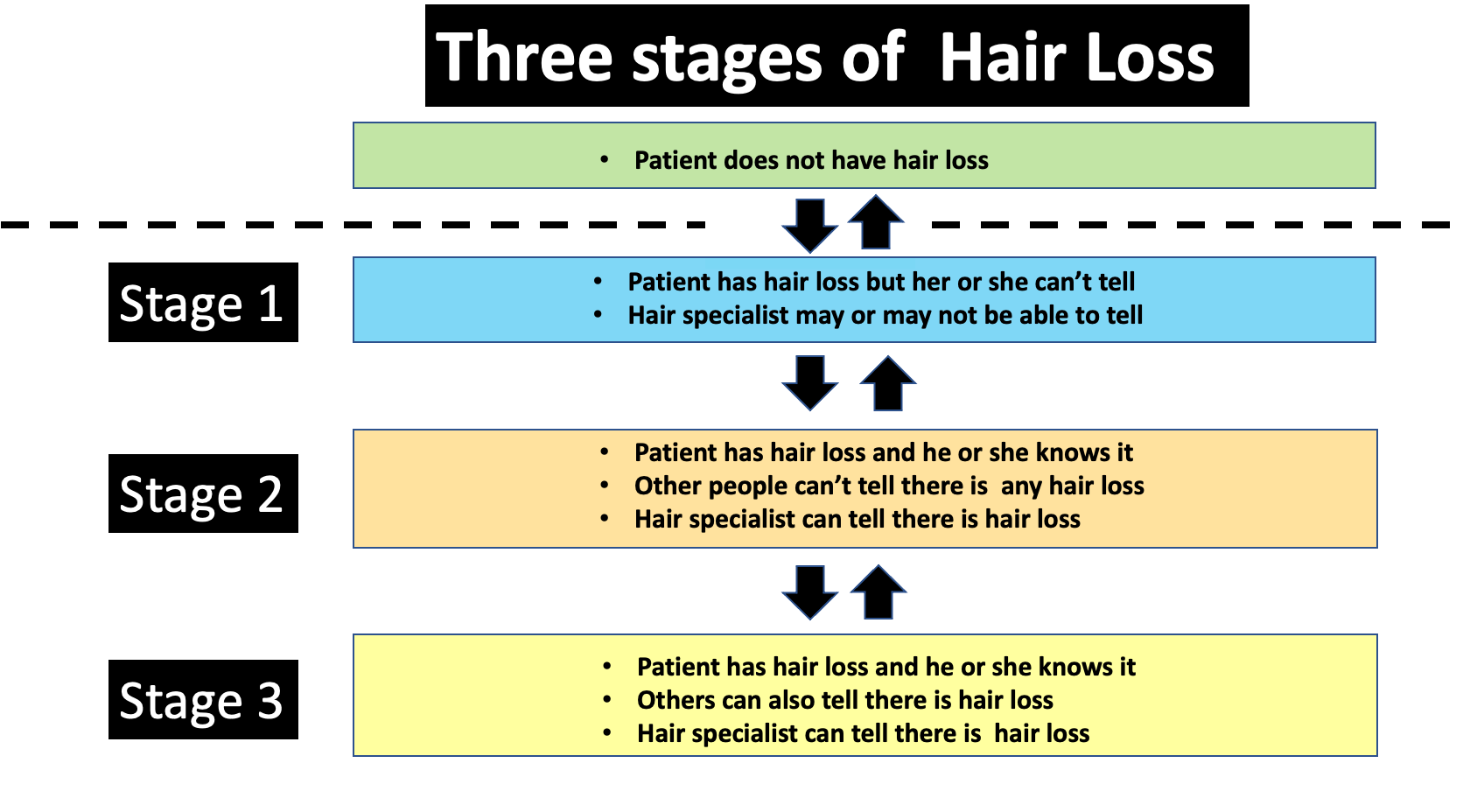Hair Loss in Androgenetic Alopecia: Why can't anyone notice my hair loss?
On the Three Stages of Hair Loss in Androgenetic Alopecia
Hair loss in patients with androgenetic alopecia (AGA) starts well before the affected individual actual becomes "aware" that his or her hair is thinning. I often think of AGA in three "stages" - labelled 1, 2 and 3 in the following diagram. These are not to be confused with the 3 Ludwig stages of hair loss.
Another way that I think about the 3 stages of hair loss is shown here.
Stage 1
In stage 1, hair density is slowly reducing but the patient is unaware. There may be a slight increase in hair being shed in the shower or coming out daily in the brush. However, this generally goes by unnoticed by the patient. A biopsy can sometimes (but not always) capture a T:V ratio below 4:1 and some degree of miniaturization (and anisotrichosis) may be present. Much of the time it's challenging to confidently diagnose AGA in this stage. Some stay in stage 1 for a very long time; others just a matter of months.
Stage 2
In stage 2, the patient first becomes aware that something is not quite right. They may see a bit more scalp showing when they look in the mirror. They may feel the hair does not feels as thick when they run their fingers through the hair. Under bright lights they may feel a bit more aware of these changes. When the hair is wet, the thinning is evident.
Nevertheless, in this second stage everyone else tells the patient they look fine. Some patients are told they are "crazy". Even some physicians will tell the patient they "look fine" and need not worry. Patients often feel isolated in this stage because nobody believes them when they say they are losing hair! A biopsy definitely shows a T:V ratio less than 4:1 and miniaturization is clearly seen in more than 20 % of hairs. Many never progress to stage 3 especially those with onset of AGA later in life.
Stage 3
In stage 3, the hair loss has progressed to a stage where hair loss may become evident not only to the patient but also to others. Of course with use of various hairstyles, products, camouflaging agents it may still be possible to hide one's hair loss from others. As stage 3 progresses it becomes more and more difficult to hide hair loss.
Comment
As a physician, I try to understand the goal of my patients. Some patients in stage 2 want help to simply stop their hair loss so that they can "stay" in stage 2 and not move on to stage 3. Other patients want treatment advice to get them back into stage 1 (if possible). Some patients in stage 3 want to improve their density such that they can get a bit more hair back to hide their hair thinning more easily. The patient in such an example may not be looking to move from stage 3 to stage 2 but may be looking to improve their density.
Consider the 31 year old female with early thinning who is worried about her hair. Her friends and family think she's crazy worrying about her hair. After listening to the patients story and examining her scalp, I can reassure her that even without treatment she will stay in stage 2 for 5-10 years (and her friends and family will likely keep telling her she's crazy for many more years to come). However, my concern for her is that if nothing is done she will move on to stage 3 in her 40s, 50s and 60s. The goal of treatment is to prevent this.
I find this chart helpful for many of my patients and when teaching physicians about hair loss.
This article was written by Dr. Jeff Donovan, a Canadian and US board certified dermatologist specializing exclusively in hair loss.


